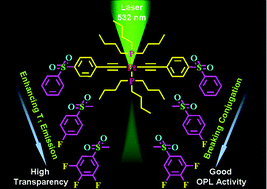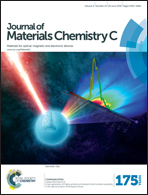Optimized trade-offs between triplet emission and transparency in Pt(ii) acetylides through phenylsulfonyl units for achieving good optical power limiting performance†
Abstract
Three Pt(II) acetylides have been prepared by coupling trans-[PtCl2(PBu3)2] to ethynyl aromatic ligands with electron-withdrawing phenylsulfonyl units in high yields (>85%). The investigation of their photophysical behavior has shown that the unique conjugation-breaking configuration of the –SO2– linker in the phenylsulfonyl units can afford a very short cut-off wavelength (λcut-off) of <390 nm to the Pt(II) acetylides, furnishing excellent transparency of these compounds. Critically, the triplet quantum yields (ΦP) of the prepared Pt(II) acetylides can be effectively enhanced from 0.52% to 15.92% through increasing the number of fluorine substituents on the phenylsulfonyl units in the organic ligands. Benefiting from their enhanced ΦP, the phenylsulfonyl-based Pt(II) acetylides can exhibit comparable or even better optical power limiting (OPL) performance against 532 nm lasers than the state-of-the-art OPL material C60, indicating their great potential in the field of laser protection. All of these results have provided a new strategy to achieve consistency between high OPL ability and good transparency for OPL materials, representing a valuable attempt for coping with key problems in the field of nonlinear optics.


 Please wait while we load your content...
Please wait while we load your content...